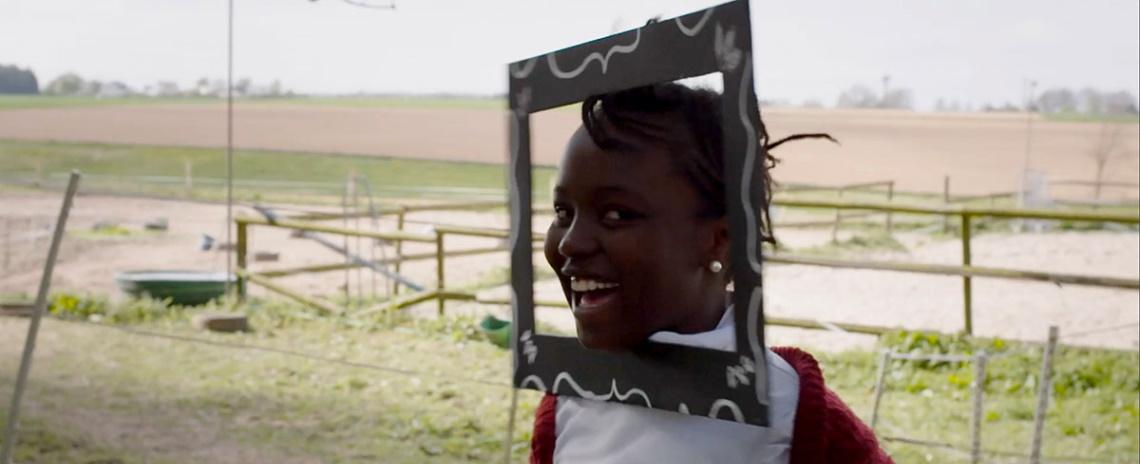On the outskirts of Paris, in the suburb of Saint-Denis, stands Dora Maar, a newly constructed middle school belonging to “the 93,” shorthand for one of the city’s most underserved postal codes. However, this is Paris, and when a new building is constructed, 1 percent of the budget goes toward an art installation of some sort. Decision heads will, in most instances, appoint an artist to construct a mosaic or statue — or some other type of art object — that can be incorporated in the new building’s layout. Dora Maar, however, sits next to a film production company, which inspired discussion around the very concept of a public-art project.
Included in this conversation was the Franco-American filmmaker and artist Éric Baudelaire. Rather than a physical public-art object, Baudelaire suggested the commissioned work be a representation of the life of the building and the young students within it. This was a clever idea, decidedly “modern” with its collectivist approach, and one with a guaranteed return of investment. (Just think of the press coverage!) It’s easy to green-light, too. Only a handful of cameras, some middle-schoolers to hold them, and an accomplished filmmaker (Baudelaire, naturally) to teach them how. And so, in 2015, the school did just that, commissioning Baudelaire and a small crew to begin filming.
“Do you have as good a chance of becoming president as someone from a fancy neighborhood?” asks an 11- or 12-year-old girl of one of her Dora Maar classmates, Guy-Yanis, early into Baudelaire’s feature. “If I said ‘yes,’ I would be lying,” he responds, adding that challenging outsider perceptions of the 93 is possible — with the proper conduct, that is. There’s also talk about Islamophobia and the 2015 terrorist attacks in Paris as they relate to the students, many of whom are practicing Muslims. Comparatively lighter matters of identity are also debated: Guy-Yanis’ parents emigrated from the Ivory Coast, so is he French or Ivorian? “He’s as French as cheese!” someone insists.
Previous to Un Film Dramatique, director Éric Baudelaire constructed films around “distant places and distant times,” as he puts it. He has worked across media, although frequently in film and photography, looking for tension between representation and reality. His most noted accomplishment, the 2011 experimental documentary The Anabasis of May and Fusako Shigenobu, Masao Adachi and 27 Years Without Images, won praise for its radical approach to historicizing the Japanese Red Army. In it, Baudelaire practices Masao Adachi’s “landscape theory,” where the camera is turned not toward the subject, but where the subject has lived. Inherent to Adachi’s theory is an explicitly Marxist take that presents the surrounding landscape as an expression of dominant power. This is the central theme in three of Baudelaire’s features — two of which were collaborations with Adachi himself — and the role it plays in Un Film Dramatique ought to be obvious.
For almost a decade now, Baudelaire has committed himself to Adachi’s brand of Marxism across film and art installations. With Un Film Dramatique, however, he seems to have lost his way. At the very least, there is an editing problem. Over four years, Baudelaire shoots his subjects as they age out of middle school. However, to viewers of Un Film Dramatique, those four years feel like one very long day. Littered across the 114-minute runtime are didactic conversations, like the ones surrounding Guy-Yanis, which desperately eat up time and, suspiciously, linger on Baudelaire’s favorite topics. What kind of feature are we making? What is a film? A photograph? And what’s the difference between them? Listening to middle-schoolers tease a response out of these spoon-fed questions is about as collaborative as this film gets.
Cameras do eventually make their way into the hands of the children. Some of the standouts record themselves eating cereal, visiting their grandma, and/or exploring their neighborhoods. However, the presence of Baudelaire is felt throughout. “[Baudelaire] says he likes when we surprise him,” a student whispers into his camera. He explains that this is why he’s shooting at night, hoping the footage pleases the director and makes it into the documentary. Here, in this sequence, Un FIlm Dramatique’s greatest flaw is laid bare: Eric Baudelaire forgot to bring himself into the equation. Or, rather, he neglected to take himself out of the picture. It's a shockingly obvious misstep, especially for a director who specializes in this theme. It also suggests that the person who made it has rarely worked with children. More than 30 years their senior, and positioning himself as “the director” of a government-funded vision, Baudelaire is the defining power structure of the film. And of course he is! It’s tough to imagine how a career Marxist wouldn’t realize this. Unless, that is, he decided to just shut his eyes and grab his paycheck.
Regardless, the film we’re left with plays like an awkward job interview between Baudelaire and the committee that commissioned him. Four years of filming and yet no one realized that there is a disproportionate power dynamic between Baudelaire the kid creators? As sweet as Dora Maar’s students might be, Un Film Dramatique will likely leave you bitter.
Rating: C
Un Film Dramatique is now available to rent via virtual cinema from the Cinema Guild. Purchase a ticket between Feb. 26 - Mar. 4 and the proceeds will help support the Webster University Film Series.


